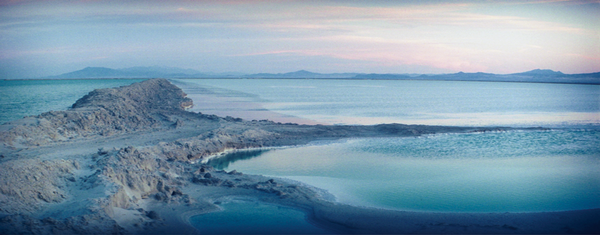
Reflections on JG, a film by Tacita Dean
Although never pictured, Robert Smithson’s Spiral Jetty (1970) haunts Tacita Dean’s most recent film JG (2013). Aperture masks mimic its spiral shape within the film (making it appear constructed from multicolored pebbles, sun rays, waves or flies, rather than from black basalt rocks and earth), while the intermittent narration of a disembodied voice quotes the writer J.G. Ballard on its perplexity. Submerged or visible depending upon the levels of the Great Salt Lake, Spiral Jetty remains elusive––merging with the landscape and reemerging from it in a cycle. The symbol of the spiral embodies a contradiction of stability and movement. In a letter to Dean, Ballard advised her to treat Spiral Jetty as a lingering mystery for her film to solve. One particular line quoted from the writer reverberates throughout the film: “Unwind the spiral and it will play back pictures of all the landscapes it has ever seen––it literally sees time.” The spiral witnesses a cycle of birth, death, destruction and recreation that shapes the landscape over time. A quiet and reflective piece, JG is a meditation on time. For Dean, the film is analogous to the Spiral Jetty; it observes the passage of time and forms a record of “all the landscapes it has ever seen.”
The film meanders across deserted landscapes of Utah and Central California, composed of water, mountains, rocks, dirt and salt, and populated with creatures from deep time––a scaly armadillo that uncoils from an egg-shaped ball, a lizard that suns on the rocks, swarming flies, and even an excavator with a crane-neck like a dinosaur. The overall stillness of Dean’s camera allows the movement to arise from the subjects within the frame––the serpentine passage of water down a slope, the energetic digging of an armadillo, the churning machinery of a potash mine. The film records familiar and localized movements while also registering the gradual accumulation of time within the landscape. Salt rings buildup in strata along the shoreline and salt crusts grow upon the heavy machinery of the potash mines. The continuous motion of the water and the machinery result in age and wear. From digging and processing the earth, the potash mine produces a stream of salt which pours down from the roof of a warehouse into a mountainous pile, like a giant hourglass. Yet the solid, rocky mountains reflect the passage of time as well, their jagged edges carved over millennia by the constant movement of water. Beyond the passage of hourly time, the film draws the viewer's attention to the traces of geological time written into the landscape.
Dean creates juxtapositions of disparate parts of the landscape through the use of aperture masks. This analog technique introduces an element of collage to the film, producing a composite image. The in-camera process involves placing a series of metal plates cut to a pattern between the negative and the lens, allowing the light source to expose only certain sections of the negative at a time. The unique-shaped masks, including an outline of mountains, the face of a clock, the Spiral Jetty, display a rough, handmade quality rather than the crisp, sharp edges of digital post-production. The most distinctive of these masks within the film resembles a strip of Ektachrome film, which fits three horizontal frames across the screen. Exposing these frames one section at a time, one pass through the camera at a time, results in three separate scenes juxtaposed. This visual and temporal collage mixes time and place in a single frame of her film. The effect can be jarring, disrupting the internal coherence of the frame, but it can also create a beautiful parallels across time. During her recent lecture at the Hammer Museum, Dean lingered on a slide that captured the line of a mountain ridge continued across all three frames of the Ektachrome mask, with each shot filmed at a different time of day. The image simultaneously conveys the passage of time and the unification of time. Moreover, the film strip itself becomes a visual and physical record of its production. The film bears the traces of the filming process and becomes, like the landscape, a record of the passage of time.
The aperture masking technique foregrounds the tactility of film both as something that bears a trace but also as something that can be physically altered. The physicality of film and its status as a record extends to its own life cycle. The time seen and held by the spiraled roll of film includes its exhibition lifespan within the gallery. Each film print has a life cycle and gradually accumulates age and wear. When the exhibition of Tacita Dean’s JG at the Hammer Museum ended, the 35mm film had passed through the projector close to 350 times. After each screening of 26 1/2 minutes, the projectionist rewound the film and threaded it back through the projector before starting it again. Looped projection of this kind is hard on film. Dust and small scratches creep into the frames and the image fades slightly over time. To avoid complete degradation of the image, two prints were provided to the museum to split the damage. Unsurprisingly, the degradation of film print during exhibition does not trouble Dean. She views each print as having an individual life. The scratches and fading are physical signs that confirm that the print has lived. Yet, each film print is only a temporary record. To sustain the stable image on the screen, the film itself must remain in constant motion and, as a result, slowly disintegrates. --Alina Sinetos, communications intern








